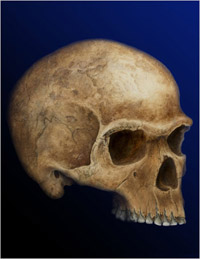Life expectancy was probably the same for early modern and late archaic humans and did not factor in the extinction of Neandertals, suggests a new study by a Washington University in St. Louis anthropologist.

Rendering of an early modern human skull.
Erik Trinkaus, PhD, the Mary Tileston Hemenway Professor and professor of physical anthropology in Arts & Sciences, examined the fossil record to assess adult mortality for both groups, which co-existed in different regions for roughly 150,000 years. Trinkaus found that the proportions of adults aged 20-40 versus adults older than 40 were about the same for early modern humans and Neandertals.
This similar age distribution, Trinkaus says, reflects similar patterns of adult mortality and treatment of the elderly in the context of highly mobile hunting-and-gathering human populations.
The study, “Late Pleistocene Adult Mortality Patterns and Modern Human Establishment,” was published electronically the week of Jan. 10 in the Proceedings of the National Academy of Sciences.
Older individuals are rarely found among the remains of late archaic humans, which has prompted some researchers to propose that Neandertals had an inherently shorter life expectancy, contributing to their demise.
However, if early modern humans did have a demographic advantage, Trinkaus argues, it was more likely due to high fertility rates and lower infant mortality.
“If indeed there was a demographic advantage for early modern humans — at least during transitional phases of Late Pleistocene human evolution — it must have been the result of increased fertility and/or reduced immature mortality,” Trinkaus writes. “Neither adult longevity nor proposed modest shifts in developmental rates are likely to have played a role in this demographic transition.”